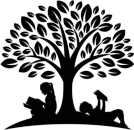Yes, you read that right! Are our balances symmetrical or asymmetrical? In our second Gymnastics lesson, children worked in groups and performed both symmetrical and asymmetrical balances. They could explain the meaning of the different terms and the importance of warming up and stretching exercises. They then worked with different partners and performed different balances, persevering and challenging themselves. While experimenting, children used strong body tension to keep their balances stable and worked safely with their partners. Finally, they made gymnastics shapes with their bodies.
Did we say shapes? In art, we are getting inspired by Sonia Delaunay, an artist who experimented with using shapes, bright colours and light to create a sense of movement in her work. This style was a branch of Abstract art called Orphism. In particular, she focused on how colours can look different depending on the other colours that are placed around them. Children found examples of colour illusion fascinating but also difficult to believe! Using the colour wheel in their books, they looked at both complementary and harmonious colours. They then explored how the placement of colours can affect each other.
In English, children wrote their own suspense stories, using short sentences and repetition to build suspense as well as long sentences for powerful descriptions of the outside and inside of haunted mansions. Needless to say that they were thrilled because they could choose their own endings. You might want to know (before you read them) that unfortunately some characters didn’t make it, their bodies were never found…
Maple class children are definitely inspired by our class book ‘Treason’. This week, in our reading sessions and in History, they learnt what Henry VIII was like through portraits and written sources. To begin with, they read descriptions of Henry VIII by his contemporaries and compiled a word wall with adjectives, describing his appearance and personality. After that, they wrote impressive speeches, with a hint of humour to engage their audience.
Over the past few weeks, we have had a busy and exciting start to our science topic of materials. We have conducted many investigations to explore a variety of concepts; making a solution, separating mixtures, and reversible and irreversible changes.
Making a Solution:
When we talk about making a solution, we mean mixing a substance (solute) with another substance (solvent) to create a mixture. When we mixed sugar with water, sugar was the solute, and water was the solvent. The sugar dissolved in the water to create a solution. However, when we mixed sand, it didn’t dissolve in water and remained separate.
Separating Mixtures:
To separate different materials, we used methods like sieving, filtering, and evaporation. Sieving is like using a strainer to separate bigger particles from smaller ones. Filtering is similar, but it’s great for separating solids from liquids. Evaporation is when we let a liquid (like water) turn into vapour, leaving behind the solid components. When we mixed sand and rice, we used a sieve to separate them. When we mixed sand with water, we used a filter to get rid of the sand. When we dissolved sugar in water, we got the sugar back by letting the water evaporate.
Reversible and Irreversible Changes:
Some changes can be undone (reversible), while others cannot (irreversible). When we mixed lemon juice with baking powder, it reacted and created a gas, making the mixture fizz. This is irreversible because we can’t easily turn the risen mixture back into its original state. We put Mentos in a bottle of Diet Coke and this reaction was also irreversible. The fizzing eruption happens because the Mentos provides sites for gas to release in the soda, and once it starts, we can’t easily stop or reverse it.
Thank you to our parents/family members who joined us for our Learning Together Morning. We looked at morphology and how this can benefit our pupils’ reading and spelling. Morphology is all about studying words and their building blocks, like prefixes, suffixes, and base words. It’s a useful way to improve reading, spelling, and understanding language. When you know about morphology, it’s like having a secret code to figure out new words. Breaking words into smaller, meaningful parts helps you learn and remember them better. Knowing how words are put together is even more helpful for reading than just knowing the sounds of letters. If you’re good at morphology, you can tackle words you’ve never seen before. Please keep an eye out in the newsletters to find out when our next one will be!
Have a lovely weekend!


















































